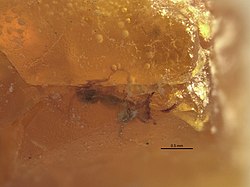Amblyoponinae
The subfamily Amblyoponinae represents nine extant genera and one fossil genus. Established by Swiss myrmecologist Auguste Forel in 1893, these ants are specialist predators, distributed worldwide in the tropics.[12][13][14]
More information Subfamily Amblyoponinae Forel, 1893 – 10 genera, 146 species, Genus name ...
Close
Aneuretinae
The subfamily Aneuretinae represents one extant genus and eight fossil genera established by Italian entomologist Carlo Emery in 1913. Only a single species of this subfamily is extant, the Sri Lankan relict ant (Aneuretus simoni), endemic to Sri Lanka.[28]
More information Subfamily Aneuretinae Emery, 1913 – nine genera, 12 species, Genus name ...
Close
Apomyrminae
The subfamily Apomyrminae contains the single genus Apomyrma which only has one species, the rare subterranean ant Apomyrma stygia from West Africa. Several undescribed species are known to exist, all from tropical Africa.[35]
More information Subfamily Apomyrminae Dlussky & Fedoseeva, 1988 – one genus, one species, Genus name ...
| Subfamily Apomyrminae Dlussky & Fedoseeva, 1988 – one genus, one species[36] |
|---|
| Genus name | Binomial authority | Classified | No. of species | Type species | Example image | Ref(s) |
| Apomyrma |
Brown, Gotwald & Levieux |
1970 |
1 |
Apomyrma stygia |

Apomyrma stygia |
[37] |
|
Close
Brownimeciinae
The subfamily Brownimeciinae contains the single genus Brownimecia which only has one species, Brownimecia clavata. It was described in 1997 after a fossilised specimen was collected from Cretaceous amber from New Jersey, and was initially placed in the subfamily Ponerinae.[38] The species was later classified into its own subfamily in 2003 by Barry Bolton.[6]
More information Subfamily †Brownimeciinae Bolton, 2003 – one genus, one species, Genus name ...
Close
Dolichoderinae
The subfamily Dolichoderinae was established by Forel in 1878, which represents 28 extant genera and 20 fossil genera. The subfamily presents a great diversity of species throughout the world, mainly in the tropics. Most species are generalised scavengers, but some are predacious.[40][41]
More information Subfamily Dolichoderinae Forel, 1878 – 48 genera, 843 species, Genus name ...
Close
Dorylinae
The subfamily Dorylinae was established by Leach in 1815, which represents 27 extant genera and one fossil genus. Many species of ant in this subfamily are known as army ants that are distributed in the Old World and New World.[76][77]
More information Genus name, Binomial authority ...
Close
Ectatomminae
The subfamily Ectatomminae represents four extant genera and three fossil genera, established in 1895 by Carlo Emery. They are distributed in tropical and warm climates in the New World and Old World, as well as the Indo-Australian regions.[41]
More information Subfamily Ectatomminae Emery, 1895 – seven genera, 278 species, Genus name ...
Close
The subfamily Formiciinae represents one extinct genus of ants dating back to the Eocene.[b] Ants of the genus Titanomyrma are the largest ants ever known, with queen specimens the size of small hummingbirds. Fossils have been collected from the state of Wyoming and in Germany.[106][107]
More information Subfamily †Formiciinae Lutz, 1986 – one, six species, Genus name ...
Close
The subfamily Formicinae represents 51 extant genera and 30 fossil genera that are globally distributed. Established by French zoologist Pierre André Latreille in 1809, the subfamily has more than 3,000 described species, placing it as the second largest ant subfamily. Despite this, the hyperdiverse genus Camponotus is the most diverse group of ants in the world, with more than 1,100 species described.[41][110]
More information Subfamily Formicinae Latreille, 1809 – 82 genera, 3,243 species, Genus name ...
Close
Haidomyrmecinae
The subfamily Haidomyrmecinae contains 9 fossil genera of specialized ants described from Cretaceous ambers. The Subfamily was previously treated as the tribe Haidomyrmecini and placed within Sphecomyrminae. The tribe was elevated to a subfamily in 2020.[160]
More information Haidomyrmecinae Bolton, 2003, Genus name ...
Close
Leptanillinae
The subfamily Leptanillinae represents nine extant genera of ants, established in 1910 by Carlo Emery. They are subterranean ants from Africa, Europe and a single species known from Australia. Studies about their biology is minimal.[167][168]
More information Subfamily Leptanillinae Emery, 1910 – nine genera, 64 species, Genus name ...
Close
Martialinae
The subfamily Martialinae contains the single genus Martialis which only has one species, Martialis heureka. The ant was discovered in 2000 Amazon rainforest near Manaus, Brazil. Described in 2008, the ant belongs to the oldest known distinct lineage to have diverged from the ancestors of all other ants.[178]
More information Subfamily Martialinae Rabeling & Verhaagh, 2008 – one genus, one species, Genus name ...
| Subfamily Martialinae Rabeling & Verhaagh, 2008 – one genus, one species[179] |
|---|
| Genus name | Binomial authority | Classified | No. of species | Type species | Example image | Ref(s) |
| Martialis |
Rabeling & Verhaagh |
2008 |
1 |
Martialis heureka |
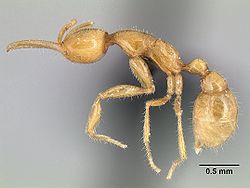
Martialis heureka |
[178] |
Close
Myrmeciinae
The subfamily Myrmeciinae represents two extant genera and five fossil genera that were once found worldwide.[d] Established by Carlo Emery in 1877, the extant genera are restricted to Australia, New Caledonia and New Zealand.[181] The notorious ant genus Myrmecia is known for their venomous stings and aggression, which has caused several human deaths in sensitive people.
More information Subfamily Myrmeciinae Emery, 1877 – seven genera, 111 species, Genus name ...
Close
Myrmicinae
The subfamily Myrmicinae was established by Lepeletier de Saint-Fargeau in 1835. It represents 142 extant genera and 36 fossil genera that are distributed globally. It is the largest subfamily of the Formicidae, with more than 6,758 species described. The seed-harvesting ants and fungus-growing ants are well known among the Myrmicines.[41][186]
More information Subfamily Myrmicinae Lepeletier de Saint-Fargeau, 1835 – 178 genera, 6,758 species, Genus name ...
| Subfamily Myrmicinae Lepeletier de Saint-Fargeau, 1835 – 178 genera, 6,758 species[186] |
|---|
| Genus name | Binomial authority | Classified | No. of species | Type species | Example image | Ref(s) |
| Acanthognathus |
Mayr |
1887 |
8 |
Acanthognathus ocellatus |

Acanthognathus ocellatus |
[79] |
| Acanthomyrmex |
Emery |
1893 |
17 |
Acanthomyrmex luciolae |

Acanthomyrmex concavus |
[31] |
| Acromyrmex |
Mayr |
1865 |
32 |
Formica hystrix |

Acromyrmex balzani |
[187] |
| Adelomyrmex |
Emery |
1897 |
30 |
Adelomyrmex biroi |

Adelomyrmex biroi |
[188] |
| Adlerzia |
Forel |
1902 |
1 |
Monomorium froggatti |

Adlerzia froggatti |
[61] |
| †Afromyrma |
Dlussky, Brothers & Rasnitsyn |
2004 |
1 |
†Afromyrma petrosa |
— |
[189] |
| †Agastomyrma |
Dlussky, Rasnitsyn & Perfilieva |
2015 |
1 |
†Agastomyrma laticeps |
— |
[190] |
| Allomerus |
Mayr |
1878 |
8 |
Allomerus decemarticulatus |

Allomerus decemarticulatus |
[191] |
| Ancyridris |
Wheeler |
1935 |
2 |
Ancyridris polyrhachioides |

Ancyridris polyrhachioides |
[192] |
| Anillomyrma |
Emery |
1913 |
2 |
Monomorium decamerum |

Anillomyrma decamera |
[193] |
| Aphaenogaster |
Mayr |
1853 |
204 |
Aphaenogaster sardoa |

Aphaenogaster swammerdami |
[194] |
| Apterostigma |
Mayr |
1865 |
47 |
Apterostigma pilosum |

Apterostigma pilosum |
[187] |
| Aretidris |
General |
2015 |
2 |
Aretidris buenaventei |

Aretidris buenaventei |
[195] |
| Atopomyrmex |
André |
1889 |
3 |
Atopomyrmex mocquerysi |

Atopomyrmex mocquerysi |
[196] |
| Atta |
Fabricius |
1804 |
17 |
Formica cephalotes |

Atta cephalotes |
[136] |
| †Attaichnus |
Laza |
1982 |
1 |
None |
— |
[197] |
| Austromorium |
Shattuck |
2009 |
2 |
Xiphomyrmex flavigaster |

Austromorium flavigaster |
[198] |
| Baracidris |
Bolton |
1981 |
3 |
Baracidris meketra |

Baracidris sitra |
[199] |
| Bariamyrma |
Lattke |
1990 |
1 |
Bariamyrma hispidula |

Bariamyrma hispidula |
[200] |
| Basiceros |
Schulz |
1906 |
8 |
Meranoplus singularis |

Basiceros manni |
[201] |
| †Biamomyrma |
Dlussky, Rasnitsyn & Perfilieva |
2015 |
3 |
†Biamomyrma zherikhini |
— |
[190] |
| †Bilobomyrma |
Radchenko & Dlussky |
2013 |
2 |
†Bilobomyrma ukrainica |
— |
[202] |
| Blepharidatta |
Wheeler |
1915 |
4 |
Blepharidatta brasiliensis |

Blepharidatta brasiliensis |
[203] |
| †Boltonidris |
Radchenko & Dlussky |
2012 |
1 |
†Boltonidris mirabilis |
— |
[204] |
| Bondroitia |
Forel |
1911 |
2 |
Monomorium coecum |

Bondroitia lujae |
[205] |
| †Brachytarsites |
Hong |
2002 |
1 |
†Brachytarsites dongzhouheensis |
— |
[125] |
| Calyptomyrmex |
Emery |
1887 |
37 |
Calyptomyrmex beccarii |

Calyptomyrmex beccarii |
[152] |
| Cardiocondyla |
Emery |
1869 |
70 |
Cardiocondyla elegans |

Cardiocondyla wroughtonii |
[206] |
| Carebara |
Westwood |
1840 |
212 |
Carebara lignata |

Carebara longii |
[207] |
| Cataulacus |
Smith |
1853 |
68 |
Cataulacus taprobanae |

Cataulacus oberthueri |
[208] |
| †Cephalomyrmex |
Carpenter |
1930 |
1 |
†Cephalomyrmex rotundatus |

†Cephalomyrmex rotundatus |
[5] |
| Cephalotes |
Latreille |
1802 |
135 |
Formica atrata |

Cephalotes atratus |
[209] |
| Chimaeridris |
Wilson |
1989 |
2 |
Chimaeridris boltoni |
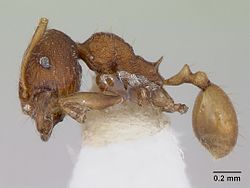
Chimaeridris boltoni |
[210] |
| †Clavipetiola |
Hong |
2002 |
1 |
†Clavipetiola asiatica |
— |
[125] |
| Colobostruma |
Wheeler |
1927 |
16 |
Epopostruma leae |

Colobostruma foliacea |
[211] |
| Crematogaster |
Lund |
1831 |
496 |
Formica scutellaris |

Crematogaster scutellaris |
[55] |
| Cryptomyrmex |
Fernández |
2004 |
2 |
Adelomyrmex longinodus |

Cryptomyrmex longinodus |
[212] |
| Cyatta |
Sosa-Calvo et al. |
2013 |
1 |
Cyatta abscondita |

Cyatta abscondita |
[213] |
| Cyphoidris |
Weber |
1952 |
4 |
Cyphoidris spinosa |

Cyphoidris spinosa |
[214] |
| Cyphomyrmex |
Mayr |
1862 |
41 |
Cyphomyrmex minutus |

Cyphomyrmex minutus |
[63] |
| Dacatria |
Rigato |
1994 |
1 |
Dacatria templaris |

Dacatria templaris |
[215] |
| Dacetinops |
Brown & Wilson |
1957 |
7 |
Dacetinops cibdelus |

Dacetinops cibdelus |
[216] |
| Daceton |
Perty |
1833 |
2 |
Formica armigera |

Daceton armigerum |
[217] |
| Diaphoromyrma |
Fernández, Delabie & Nascimento |
2009 |
1 |
Diaphoromyrma sofiae |

Diaphoromyrma sofiae |
[218] |
| Dicroaspis |
Emery |
1908 |
2 |
Dicroaspis cryptocera |

Dicroaspis cryptocera |
[219] |
| Dilobocondyla |
Santschi |
1910 |
19 |
Atopomyrmex selebensis |

Dilobocondyla fouqueti |
[220] |
| Diplomorium |
Mayr |
1901 |
1 |
Diplomorium longipenne |

Diplomorium longipenne |
[221] |
| Dolopomyrmex |
Cover & Deyrup |
2007 |
1 |
Dolopomyrmex pilatus |

Dolopomyrmex pilatus |
[222] |
| †Electromyrmex |
Wheeler |
1910 |
1 |
†Electromyrmex klebsi |

†Electromyrmex klebsi |
[223] |
| †Enneamerus |
Mayr |
1868 |
1 |
†Enneamerus reticulatus |

†Enneamerus reticulatus |
[130] |
| †Eocenidris |
Wilson |
1985 |
1 |
†Eocenidris crassa |

†Eocenidris crassa |
[151] |
| †Eocenomyrma |
Dlussky & Radchenko |
2006 |
4 |
†Eocenomyrma orthospina |

†Eocenomyrma orthospina |
[224] |
| †Eomyrmex |
Hong |
1974 |
1 |
†Eomyrmex guchengziensis |
— |
[225] |
| Epelysidris |
Bolton |
1987 |
1 |
Epelysidris brocha |

Epelysidris brocha |
[226] |
| Epopostruma |
Forel |
1895 |
19 |
Strumigenys quadrispinosa |

Epopostruma natalae |
[73] |
| Eurhopalothrix |
Brown & Kempf |
1961 |
53 |
Rhopalothrix bolaui |

Eurhopalothrix bolaui |
[227] |
| Eutetramorium |
Emery |
1899 |
3 |
Eutetramorium mocquerysi |

Eutetramorium mocquerysi |
[228] |
| †Fallomyrma |
Dlussky & Radchenko |
2006 |
1 |
†Fallomyrma transversa |
— |
[229] |
| Formicoxenus |
Mayr |
1855 |
7 |
Myrmica nitidula |
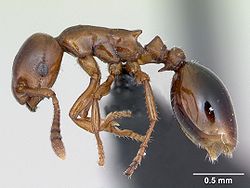
Formicoxenus nitidulus |
[230] |
| Formosimyrma |
Terayama |
2009 |
1 |
Formosimyrma lanuyensis |

Formosimyrma lanuyensis |
[231] |
| †Fushunomyrmex |
Hong |
2002 |
1 |
†Fushunomyrmex liaoningensis |
— |
[125] |
| Gaoligongidris |
Xu |
2012 |
1 |
Gaoligongidris planodorsa |
— |
[232] |
| Gauromyrmex |
Menozzi |
1933 |
2 |
Gauromyrmex bengakalisi |

Gauromyrmex bengakalisi |
[233] |
| Goniomma |
Emery |
1895 |
8 |
Aphaenogaster blanci |

Goniomma collingwoodi |
[234] |
| Harpagoxenus |
Forel |
1893 |
3 |
Myrmica sublaevis |

Harpagoxenus sublaevis |
[235] |
| Huberia |
Forel |
1890 |
2 |
Tetramorium striatum |

Huberia striata |
[236] |
| Hylomyrma |
Forel |
1912 |
13 |
Pogonomyrmex columbicus |

Hylomyrma balzani |
[237] |
| †Hypopomyrmex |
Emery |
1891 |
1 |
†Hypopomyrmex bombiccii |

†Hypopomyrmex bombiccii |
[238] |
| †Ilemomyrmex |
Wilson |
1985 |
1 |
†Ilemomyrmex caecus |

†Ilemomyrmex caecus |
[239] |
| Indomyrma |
Brown |
1986 |
2 |
Indomyrma dasypyx |

Indomyrma dasypyx |
[240] |
| Ishakidris |
Bolton |
1984 |
1 |
Ishakidris ascitaspis |

Ishakidris ascitaspis |
[241] |
| Kalathomyrmex |
Klingenberg & Brandão |
2009 |
1 |
Myrmicocrypta emeryi |

Kalathomyrmex emeryi |
[242] |
| Kartidris |
Bolton |
1991 |
6 |
Kartidris nyos |

Kartidris nyos |
[243] |
| Kempfidris |
Fernández, Feitosa & Lattke |
2014 |
1 |
Monomorium inusuale |

Kempfidris inusualis |
[244] |
| Lachnomyrmex |
Wheeler |
1910 |
16 |
Lachnomyrmex scrobiculatus |

Lachnomyrmex scrobiculatus |
[8] |
| Lasiomyrma |
Terayama & Yamane |
2000 |
4 |
Lasiomyrma gedensis |

Lasiomyrma gedensis |
[245] |
| Lenomyrmex |
Fernández & Palacio |
1999 |
6 |
Lenomyrmex mandibularis |

Lenomyrmex colwelli |
[246] |
| Leptothorax |
Mayr |
1855 |
19 |
Formica acervorum |

Leptothorax acervorum |
[230] |
| Liomyrmex |
Mayr |
1865 |
1 |
Myrmica caeca |

Liomyrmex gestroi |
[187] |
| †Lonchomyrmex |
Mayr |
1867 |
2 |
†Lonchomyrmex freyeri |
— |
[247] |
| Lophomyrmex |
Emery |
1892 |
13 |
Oecodoma quadrispinosa |

Lophomyrmex longicornis |
[248] |
| Lordomyrma |
Emery |
1897 |
34 |
Lordomyrma furcifera |

Lordomyrma furcifera |
[188] |
| Malagidris |
Bolton & Fisher |
2014 |
6 |
Aphaenogaster belti |

Malagidris belti |
[249] |
| Manica |
Jurine |
1807 |
6 |
Formica rubida |

Manica rubida |
[88] |
| Mayriella |
Forel |
1902 |
9 |
Mayriella abstinens |

Mayriella abstinens |
[61] |
| Megalomyrmex |
Forel |
1885 |
44 |
Megalomyrmex leoninus |

Megalomyrmex leoninus |
[250] |
| Melissotarsus |
Emery |
1877 |
4 |
Melissotarsus beccarii |

Melissotarsus beccarii |
[251] |
| Meranoplus |
Smith |
1853 |
90 |
Cryptocerus bicolor |

Meranoplus bicolor |
[208] |
| Mesostruma |
Brown |
1948 |
9 |
Strumigenys turneri |

Mesostruma turneri |
[252] |
| Messor |
Forel |
1890 |
110 |
Formica barbara |

Messor barbarus |
[253] |
| Metapone |
Forel |
1911 |
18 |
Metapone greeni |

Metapone emersoni |
[254] |
| Microdaceton |
Santschi |
1913 |
4 |
Microdaceton exornatum |

Microdaceton exornatum |
[255] |
| †Miosolenopsis |
Zhang |
1989 |
1 |
†Miosolenopsis fossilis |
— |
[43] |
| Monomorium |
Mayr |
1855 |
372 |
Monomorium monomorium |

Monomorium pharaonis |
[230] |
| Mycetagroicus |
Brandão & Mayhé-Nunes |
2001 |
4 |
Mycetagroicus cerradensis |

Mycetagroicus cerradensis |
[256] |
| Mycetarotes |
Emery |
1913 |
4 |
Cyphomyrmex parallelus |

Mycetarotes parallelus |
[193] |
| Mycetophylax |
Emery |
1913 |
3 |
Myrmicocrypta brittoni |

Mycetophylax conformis |
[193] |
| Mycetosoritis |
Wheeler |
1907 |
5 |
Atta hartmanni |

Mycetosoritis hartmanni |
[257] |
| Mycocepurus |
Forel |
1893 |
6 |
Atta smithii |

Mycocepurus smithii |
[258] |
| Myrmecina |
Curtis |
1829 |
51 |
Myrmecina latreillii |

Myrmecina graminicola |
[259] |
| †Myrmecites |
Dlussky & Rasnitsyn |
2003 |
6 |
†Myrmecites rotundiceps |
— |
[260] |
| Myrmica |
Latreille |
1804 |
211 |
Formica rubra |

Myrmica rubra |
[86] |
| Myrmicaria |
Saunders |
1842 |
32 |
Myrmicaria brunnea |

Myrmicaria brunnea |
[261] |
| Myrmicocrypta |
Smith |
1860 |
27 |
Myrmicocrypta squamosa |

Myrmicocrypta squamosa |
[262] |
| Myrmisaraka |
Bolton & Fisher |
2014 |
2 |
Myrmisaraka producta |

Myrmisaraka producta |
[249] |
| Nesomyrmex |
Wheeler |
1910 |
57 |
Nesomyrmex clavipilis |

Nesomyrmex angulatus |
[8] |
| Novomessor |
Emery |
1915 |
3 |
Aphaenogaster cockerelli |

Novomessor cockerelli |
[263] |
| Ochetomyrmex |
Mayr |
1878 |
2 |
Ochetomyrmex semipolitus |

Ochetomyrmex semipolitus |
[191] |
| Octostruma |
Forel |
1912 |
34 |
Rhopalothrix simoni |

Octostruma iheringi |
[264] |
| Ocymyrmex |
Emery |
1886 |
37 |
Ocymyrmex barbiger |

Ocymyrmex dekerus |
[265] |
| †Orbigastrula |
Hong |
2002 |
1 |
†Orbigastrula guchengziensis |
— |
[125] |
| Orectognathus |
Smith |
1853 |
29 |
Orectognathus antennatus |

Orectognathus antennatus |
[208] |
| Oxyepoecus |
Santschi |
1926 |
21 |
Oxyepoecus bruchi |

Oxyepoecus bruchi |
[266] |
| †Oxyidris |
Wilson |
1985 |
1 |
†Oxyidris antillana |

†Oxyidris antillana |
[239] |
| Oxyopomyrmex |
André |
1881 |
12 |
Oxyopomyrmex oculatus |
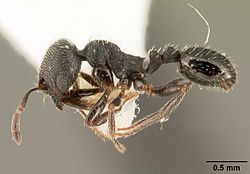
Oxyopomyrmex oculatus |
[267] |
| †Parameranoplus |
Wheeler |
1915 |
1 |
†Parameranoplus primaevus |

†Parameranoplus primaevus |
[9] |
| Paramycetophylax |
Kusnezov |
1956 |
1 |
Sericomyrmex bruchi |

Paramycetophylax bruchi |
[268] |
| †Paraphaenogaster |
Dlussky |
1981 |
4 |
†Paraphaenogaster microphthalmus |

†Paraphaenogaster hooleyana |
[64] |
| Paratopula |
Wheeler |
1919 |
11 |
Atopomyrmex ceylonicus |

Paratopula macta |
[269] |
| Patagonomyrmex |
Johnson & Moreau |
2016 |
3 |
Pogonomyrmex angustus |

Patagonomyrmex angustus |
[270] |
| Perissomyrmex |
Smith |
1947 |
6 |
Perissomyrmex snyderi |

Perissomyrmex snyderi |
[271] |
| Peronomyrmex |
Viehmeyer |
1922 |
3 |
Peronomyrmex overbecki |

Peronomyrmex greavesi |
[272] |
| Phalacromyrmex |
Kempf |
1960 |
1 |
Phalacromyrmex fugax |

Phalacromyrmex fugax |
[273] |
| Pheidole |
Westwood |
1839 |
1007 |
Atta providens |

Pheidole rhea |
[274] |
| Pilotrochus |
Brown |
1978 |
1 |
Pilotrochus besmerus |

Pilotrochus besmerus |
[275] |
| †Plesiomyrmex |
Dlussky & Radchenko |
2009 |
1 |
†Plesiomyrmex tubulatus |
— |
[276] |
| Podomyrma |
Smith |
1859 |
52 |
Podomyrma femorata |

Podomyrma minor |
[277] |
| Poecilomyrma |
Mann |
1921 |
2 |
Poecilomyrma senirewae |

Poecilomyrma senirewae |
[278] |
| Pogonomyrmex |
Mayr |
1868 |
69 |
Formica badia |

Camponotus badius |
[118] |
| Pristomyrmex |
Mayr |
1866 |
60 |
Pristomyrmex pungens |

Pristomyrmex punctatus |
[96] |
| Proatta |
Forel |
1912 |
1 |
Proatta butteli |

Proatta butteli |
[279] |
| Procryptocerus |
Emery |
1887 |
45 |
Meranoplus striatus |

Procryptocerus hylaeus |
[152] |
| Propodilobus |
Branstetter |
2009 |
1 |
Stenamma orientale |

Propodilobus orientale |
[280] |
| Protalaridris |
Brown |
1980 |
1 |
Protalaridris armata |

Protalaridris armata |
[281] |
| †Protomyrmica |
Dlussky & Radchenko |
2009 |
1 |
†Protomyrmica atavia |

†Protomyrmica atavia |
[276] |
| Pseudoatta |
Gallardo |
1916 |
1 |
Pseudoatta argentina |

Pseudoatta argentina |
[282] |
| †Quadrulicapito |
Hong |
2002 |
1 |
†Quadrulicapito longa |
— |
[125] |
| †Quineangulicapito |
Hong |
2002 |
1 |
†Quineangulicapito fushunensis |
— |
[125] |
| Recurvidris |
Bolton |
1992 |
11 |
None |
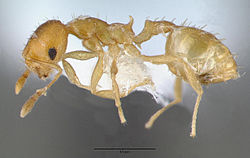
Recurvidris recurvispinosa |
[283] |
| Rhopalomastix |
Forel |
1900 |
6 |
Rhopalomastix rothneyi |

Rhopalomastix rothneyi |
[284] |
| Rhopalothrix |
Mayr |
1870 |
16 |
Rhopalothrix ciliata |

Rhopalothrix ciliata |
[285] |
| Rogeria |
Emery |
1894 |
40 |
Rogeria curvipubens |
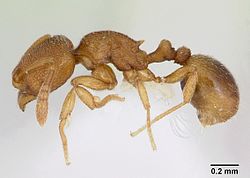
Rogeria curvipubens |
[286] |
| Romblonella |
Wheeler |
1935 |
9 |
Romblonella grandinodis |

Romblonella opaca |
[192] |
| Rostromyrmex |
Rosciszewski |
1994 |
1 |
Rostromyrmex pasohensis |

Rostromyrmex pasohensis |
[287] |
| Rotastruma |
Bolton |
1991 |
2 |
Rotastruma recava |

Rotastruma recava |
[243] |
| Royidris |
Bolton & Fisher |
2014 |
15 |
Monomorium robertsoni |

Royidris robertsoni |
[249] |
| Secostruma |
Bolton |
1988 |
1 |
Secostruma lethifera |

Secostruma lethifera |
[288] |
| Sericomyrmex |
Mayr |
1865 |
19 |
Sericomyrmex opacus |

Sericomyrmex amabilis |
[187] |
| †Sinomyrmex |
Hong |
2002 |
2 |
†Sinomyrmex brunneus |
— |
[125] |
| Solenopsis |
Westwood |
1840 |
205 |
Solenopsis mandibularis |
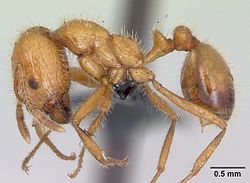
Solenopsis geminata |
[207] |
| †Solenopsites |
Dlussky & Rasnitsyn |
2003 |
3 |
†Solenopsites minutus |

†Solenopsites rossi |
[260] |
| †Sphaerogasterites |
Hong |
2002 |
1 |
†Sphaerogasterites longipetiolatus |
— |
[125] |
| Stegomyrmex |
Emery |
1912 |
5 |
Stegomyrmex connectens |

Stegomyrmex vizottoi |
[289] |
| Stenamma |
Westwood |
1839 |
85 |
Stenamma westwoodii |

Stenamma westwoodii |
[274] |
| Stereomyrmex |
Emery |
1901 |
3 |
Stereomyrmex horni |

Stereomyrmex horni |
[290] |
| †Stigmomyrmex |
Mayr |
1868 |
1 |
†Stigmomyrmex venustus |

†Stigmomyrmex venustus |
[130] |
| †Stiphromyrmex |
Wheeler |
1915 |
1 |
†Stiphromyrmex robustus |

†Stiphromyrmex robustus |
[9] |
| Strongylognathus |
Mayr |
1853 |
24 |
Eciton testaceum |

Strongylognathus testaceus |
[291][292] |
| Strumigenys |
Smith |
1860 |
842 |
Strumigenys mandibularis |

Strumigenys abdera |
[262] |
| Syllophopsis |
Santschi |
1915 |
20 |
Monomorium modestum |

Syllophopsis modesta |
[293] |
| Talaridris |
Weber |
1941 |
1 |
Talaridris mandibularis |

Talaridris mandibularis |
[48] |
| Temnothorax |
Mayr |
1861 |
395 |
Myrmica recedens |

Temnothorax unifasciatus |
[67] |
| Terataner |
Emery |
1912 |
12 |
Atopomyrmex foreli |

Terataner foreli |
[289] |
| Tetheamyrma |
Bolton |
1991 |
1 |
Tetheamyrma subspongia |
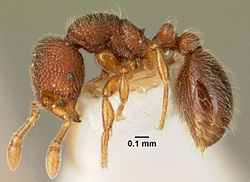
Tetheamyrma subspongia |
[243] |
| Tetramorium |
Mayr |
1855 |
569 |
Formica caespitum |

Tetramorium caespitum |
[230] |
| Trachymyrmex |
Forel |
1893 |
48 |
Atta septentrionalis |

Trachymyrmex septentrionalis |
[258] |
| Tranopelta |
Mayr |
1866 |
2 |
Tranopelta gilva |

Tranopelta gilva |
[25] |
| Trichomyrmex |
Mayr |
1865 |
18 |
Trichomyrmex rogeri |

Trichomyrmex destructor |
[187] |
| Tropidomyrmex |
Silva, Feitosa, Brandão & Diniz |
2009 |
1 |
Tropidomyrmex elianae |

Tropidomyrmex elianae |
[294] |
| Tyrannomyrmex |
Fernández |
2003 |
3 |
Tyrannomyrmex rex |

Tyrannomyrmex dux |
[295] |
| Veromessor |
Forel |
1917 |
9 |
Aphaenogaster andrei |

Veromessor andrei |
[296] |
| Vitsika |
Bolton & Fisher |
2014 |
14 |
Vitsika crebra |

Vitsika crebra |
[249] |
| Vollenhovia |
Mayr |
1865 |
62 |
Vollenhovia punctatostriata |

Vollenhovia emeryi |
[187] |
| Vombisidris |
Bolton |
1991 |
17 |
Vombisidris philax |

Vombisidris philax |
[243] |
| Wasmannia |
Forel |
1893 |
11 |
Tetramorium auropunctatum |

Wasmannia auropunctata |
[297] |
| †Wumyrmex |
Hong |
2002 |
1 |
†Wumyrmex furvis |
— |
[125] |
| Xenomyrmex |
Forel |
1885 |
4 |
Xenomyrmex stollii |

Xenomyrmex stollii |
[250] |
| †Zhangidris |
Bolton |
2003 |
1 |
†Heteromyrmex atopogaster |
— |
[6] |
Close
Paraponerinae
The subfamily Paraponerinae contains a single genus Paraponera. This genus has two species, one of which was found in Dominican amber from the Miocene.[298] The extant species, Paraponera clavata, is found in Central America and South America, and the pain from its sting is said to be greater than any other insect sting on earth.[299]
More information Subfamily Paraponerinae Emery, 1901 – one genus, two species, Genus name ...
Close
Ponerinae
The subfamily Ponerinae was established by Lepeletier de Saint-Fargeau in 1835, which represents 47 extant genera and 12 fossil genera. The subfamily is among the most diverse in the family Formicidae, with more than 1,000 species described. They are mostly distributed in the tropics and subtropics.[6][41]
More information Subfamily Ponerinae Lepeletier de Saint-Fargeau, 1835 – 59 genera, 1,287 species, Genus name ...
Close
Proceratiinae
The subfamily Proceratiinae was established by Italian entomologist Carlo Emery in 1895, which represents three extant genera and one extinct genus. Found worldwide, these ants are mainly encountered in tropical and subtropical areas. Little is known about their biology.[41][318]
More information Subfamily Proceratiinae Emery, 1895 – four genera, 155 species, Genus name ...
Close
Pseudomyrmecinae
The subfamily Pseudomyrmecinae was established by M.R. Smith in 1952,[320] which represents three genera of ants that are primarily arboreal nesting ants in the tropical and subtropical regions.[321] They are found in Africa, Asia, Australia, North America and South America.[322]
More information Subfamily Pseudomyrmecinae Smith, 1952 – three genera, 251 species, Genus name ...
Close
Sphecomyrminae
The subfamily Sphecomyrminae contains 9 fossil genera of stem ants. Most fossilized ants from Cretaceous amber were placed in this subfamily, however revisions in 2017 and 2020 removed several genera and added former members of the subfamily Armaniinae.[1][326][160]
More information Subfamily Sphecomyrminae Wilson & Brown, 1967, Genus name ...
Close




















































































































































